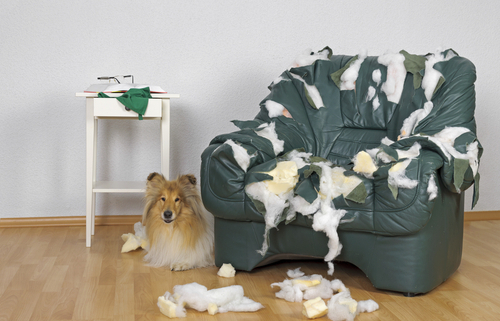Damaged Furniture? We Can Help!
Dogs are loyal, loving companions, but are also notorious for being mischievous. While puppies often chew on furniture while teething, even adult dogs are known to chew off a chair leg or gnaw on dining tables, dressers, consoles and couches. This usually happens when the dog suffers from separation anxiety and is feeling frustrated, as the act of chewing pacifies and soothes a dog that is feeling anxious and trying to find an outlet for all the pent-up energy.
How do you repair furniture that has been chewed on by a dog? We are here to help! Please following our steps below.
- Grab some high-quality wood filler which can be molded to take the required shape and adheres easily to wooden furniture.
- To begin repairs, make sure that you clean the chewed portions carefully. Since the surface could be chewed upon unevenly, you need to create a surface that is easier to work with. Use a scratch awl and remove any splintered pieces of wood to create a small recess that is at least ¼ of an inch.
- To smoothen out jagged edges, scuff the area with 120 grit sandpaper. This will remove any pointed edges and allow the putty to adhere to the furniture properly.
- If the damage is substantial, use epoxy wood putty that is slightly lighter in color than the furniture. Using a putty knife, press the epoxy into the recess created to cover the chew marks. If the damage is smaller, use the wood filler you have with an activator – one that comes in a squeeze tube. Mix the two together, and quickly fill up the damage. Make sure you work quickly as the filler will harden within a couple of minutes, and then become impossible to re-shape and re-fill. Make sure that you cover all edges and blend the filler with the furniture without leaving out any gaps.
- Let the filler dry for about 20 minutes. Once it has adhered to the furniture and become a solid mass, use a sandpaper to again smoothen out the edges. The aim here is to create a seamless repair, where one cannot tell the actual wood apart from the filler for an immaculate finish. Once you have sanded the area and are satisfied with the repair, use a clean cloth to wipe off any dust particles before you apply the finishing coat.
- Based on your furniture, you can either paint over the repair to blend it with the rest of the furniture or use a wood polish. If using paint, make sure you choose a color one shade lighter than the original paint. This is because, paint can darken after drying. Once the paint dries and you think it needs to be a shade darker to blend in perfectly, you can apply another coat. If all your furniture requires is a wood polish, use a poly brush and carefully cover the repairs for a flawless finish.



